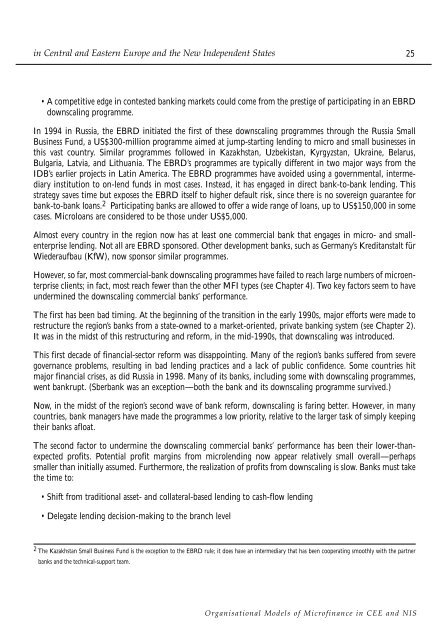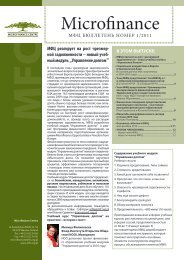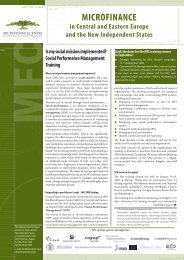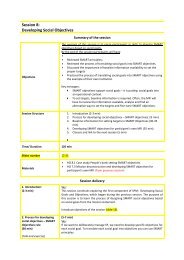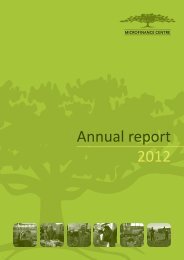In Central And Eastern Europe - Microfinance Centre
In Central And Eastern Europe - Microfinance Centre
In Central And Eastern Europe - Microfinance Centre
You also want an ePaper? Increase the reach of your titles
YUMPU automatically turns print PDFs into web optimized ePapers that Google loves.
in <strong>Central</strong> and <strong>Eastern</strong> <strong>Europe</strong> and the New <strong>In</strong>dependent States<br />
25<br />
• A competitive edge in contested banking markets could come from the prestige of participating in an EBRD<br />
downscaling programme.<br />
<strong>In</strong> 1994 in Russia, the EBRD initiated the first of these downscaling programmes through the Russia Small<br />
Business Fund, a US$300-million programme aimed at jump-starting lending to micro and small businesses in<br />
this vast country. Similar programmes followed in Kazakhstan, Uzbekistan, Kyrgyzstan, Ukraine, Belarus,<br />
Bulgaria, Latvia, and Lithuania. The EBRD’s programmes are typically different in two major ways from the<br />
IDB’s earlier projects in Latin America. The EBRD programmes have avoided using a governmental, intermediary<br />
institution to on-lend funds in most cases. <strong>In</strong>stead, it has engaged in direct bank-to-bank lending. This<br />
strategy saves time but exposes the EBRD itself to higher default risk, since there is no sovereign guarantee for<br />
bank-to-bank loans. 2 Participating banks are allowed to offer a wide range of loans, up to US$150,000 in some<br />
cases. Microloans are considered to be those under US$5,000.<br />
Almost every country in the region now has at least one commercial bank that engages in micro- and smallenterprise<br />
lending. Not all are EBRD sponsored. Other development banks, such as Germany’s Kreditanstalt für<br />
Wiederaufbau (KfW), now sponsor similar programmes.<br />
However, so far, most commercial-bank downscaling programmes have failed to reach large numbers of microenterprise<br />
clients; in fact, most reach fewer than the other MFI types (see Chapter 4). Two key factors seem to have<br />
undermined the downscaling commercial banks’ performance.<br />
The first has been bad timing. At the beginning of the transition in the early 1990s, major efforts were made to<br />
restructure the region’s banks from a state-owned to a market-oriented, private banking system (see Chapter 2).<br />
It was in the midst of this restructuring and reform, in the mid-1990s, that downscaling was introduced.<br />
This first decade of financial-sector reform was disappointing. Many of the region’s banks suffered from severe<br />
governance problems, resulting in bad lending practices and a lack of public confidence. Some countries hit<br />
major financial crises, as did Russia in 1998. Many of its banks, including some with downscaling programmes,<br />
went bankrupt. (Sberbank was an exception—both the bank and its downscaling programme survived.)<br />
Now, in the midst of the region’s second wave of bank reform, downscaling is faring better. However, in many<br />
countries, bank managers have made the programmes a low priority, relative to the larger task of simply keeping<br />
their banks afloat.<br />
The second factor to undermine the downscaling commercial banks’ performance has been their lower-thanexpected<br />
profits. Potential profit margins from microlending now appear relatively small overall—perhaps<br />
smaller than initially assumed. Furthermore, the realization of profits from downscaling is slow. Banks must take<br />
the time to:<br />
• Shift from traditional asset- and collateral-based lending to cash-flow lending<br />
• Delegate lending decision-making to the branch level<br />
2 The Kazakhstan Small Business Fund is the exception to the EBRD rule; it does have an intermediary that has been cooperating smoothly with the partner<br />
banks and the technical-support team.<br />
Organisational Models of <strong>Microfinance</strong> in CEE and NIS


